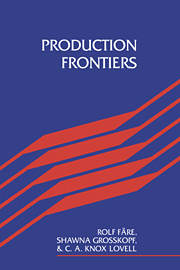Book contents
- Frontmatter
- Contents
- List of Figures
- List of Tables
- Preface
- 1 Introduction
- 2 Production Technology
- 3 Input-Based Efficiency Measurement
- 4 Output-Based Efficiency Measurement
- 5 Indirect Input-Based Efficiency Measurement
- 6 Indirect Output-Based Efficiency Measurement
- 7 The Measurement of Price Efficiency
- 8 Graph Efficiency Measurement
- 9 Efficiency Measurement and Productivity Measurement
- 10 Topics in Efficiency Measurement
- A Standard Notations and Mathematical Appendix
- References
- Biographical Index
- Index
10 - Topics in Efficiency Measurement
Published online by Cambridge University Press: 23 October 2009
- Frontmatter
- Contents
- List of Figures
- List of Tables
- Preface
- 1 Introduction
- 2 Production Technology
- 3 Input-Based Efficiency Measurement
- 4 Output-Based Efficiency Measurement
- 5 Indirect Input-Based Efficiency Measurement
- 6 Indirect Output-Based Efficiency Measurement
- 7 The Measurement of Price Efficiency
- 8 Graph Efficiency Measurement
- 9 Efficiency Measurement and Productivity Measurement
- 10 Topics in Efficiency Measurement
- A Standard Notations and Mathematical Appendix
- References
- Biographical Index
- Index
Summary
Introduction
In each of the earlier chapters in this monograph, we have focused on a single general topic. In contrast, this chapter contains several topics, all of which allow for customization of the models already introduced in this manuscript. As we shall see, the programming framework readily allows such customization – additional constraints may be added in a straightforward way, and behavioral objectives also may be modified readily, allowing us to identify the frontier in nontraditional or restricted cases and to measure easily deviations from those frontiers. These topics are intended to be suggestive and not exhaustive; they are an invitation to the reader to extend the models introduced here to suit their area of interest.
In Section 10.1 we discuss subvector efficiency. By subvector efficiency we understand that only some inputs or some outputs are exposed to scaling while the others are fixed. This allows us to consider short-run efficiency, for example.
Constrained profit maximization is the topic of Section 10.2. In this section we demonstrate how to formulate profit maximization in a programming framework, and how to modify the basic problem to account for fixed inputs as well as for constraints which limit expenditure on a subvector of inputs. An example of this type of constraint is a credit constraint faced by a producer purchasing variable inputs.
Measures of plant capacity and its utilization are introduced in Section 10.3. Here we investigate capacity in terms of inputs and outputs rather than in terms of cost, in order to provide an operational measure of the notion of capacity as defined by Johansen (1968), which seeks maximum achievable output given fixed inputs, but allowing unrestricted application of variable inputs.
- Type
- Chapter
- Information
- Production Frontiers , pp. 241 - 270Publisher: Cambridge University PressPrint publication year: 1993



